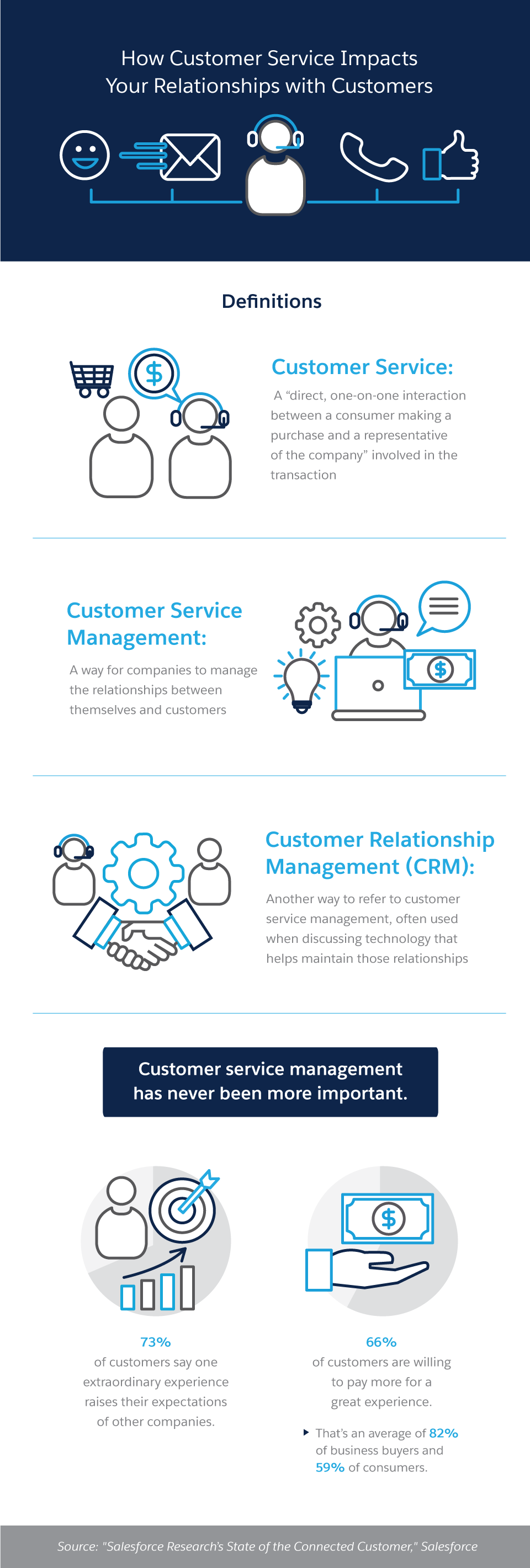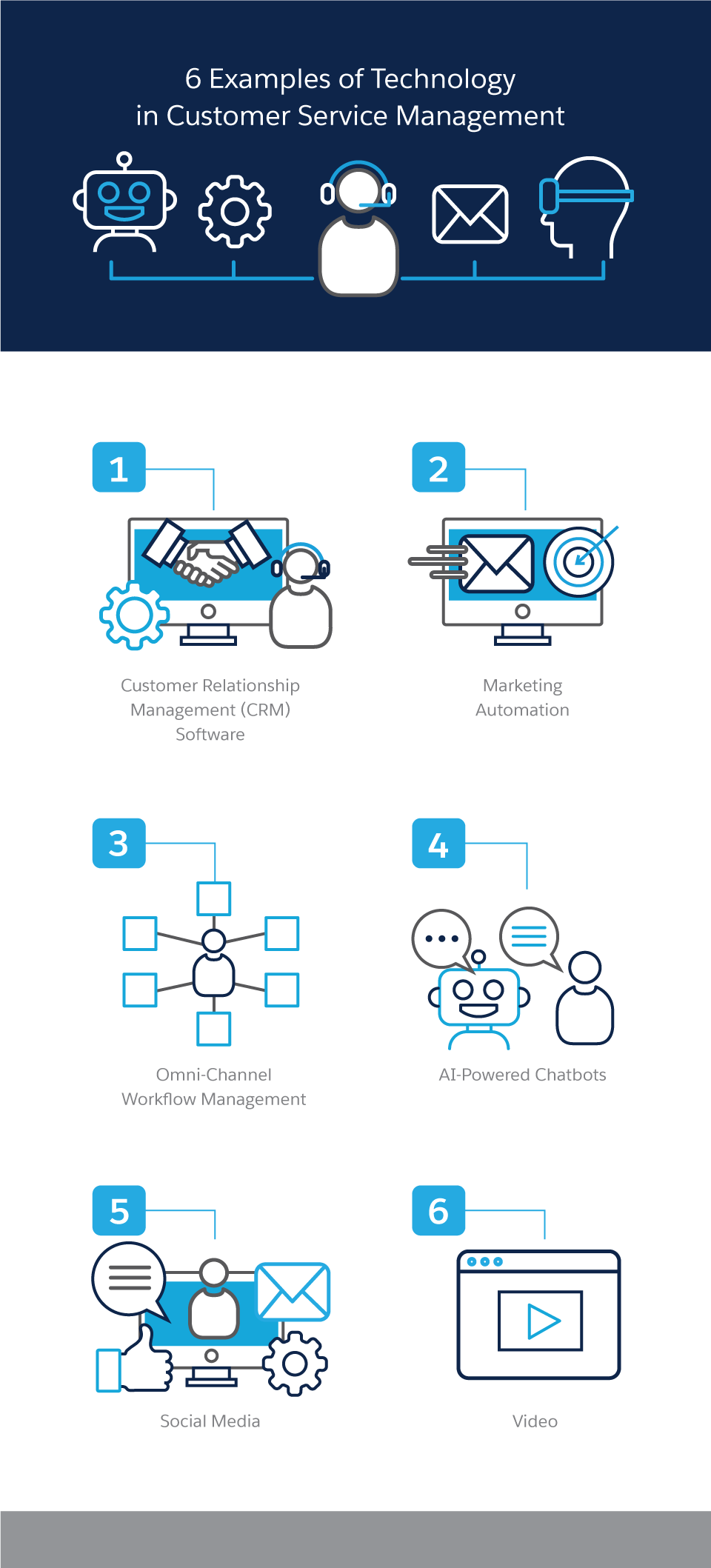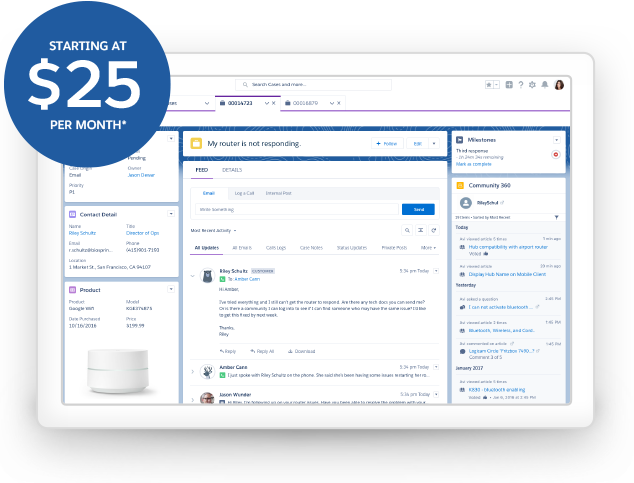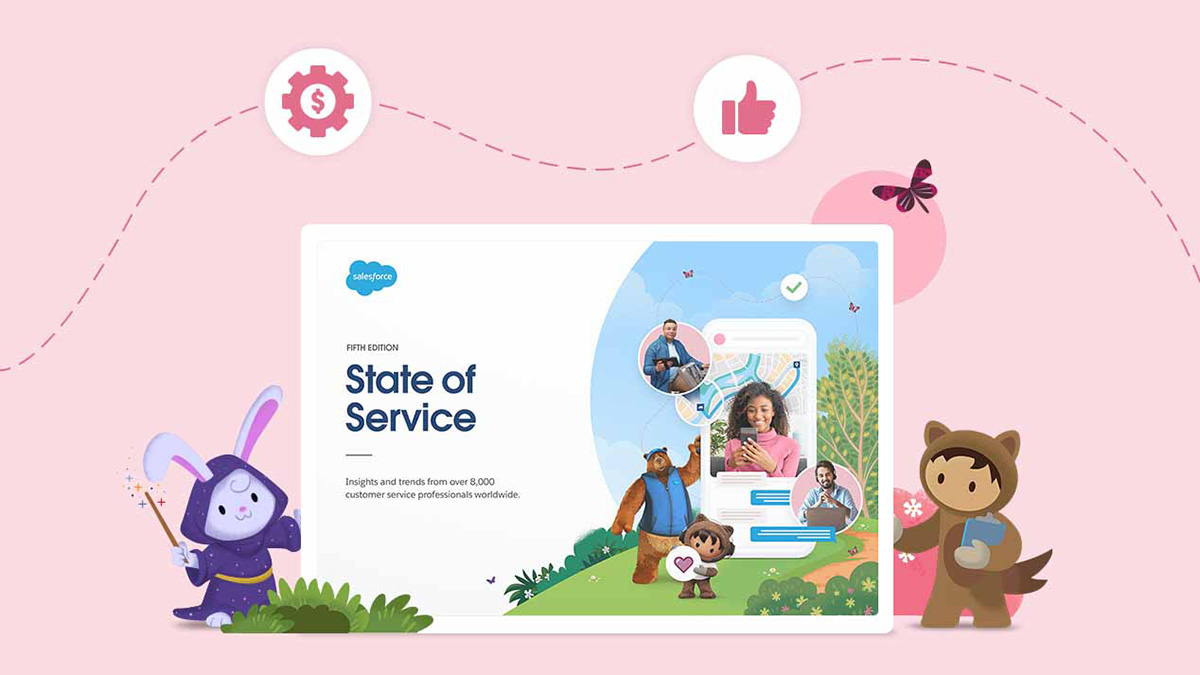Customer Service Management | Key Benefits and Strategies
Time to read: 10 minutes
Crucial for Business Success: A positive or negative customer service experience significantly impacts a business.
Influences Customer Loyalty: 94% of customers are more likely to repurchase after a positive service experience, and 80% are willing to forgive a company's mistake if the service is excellent.
Essential for Growth: As a business expands, robust customer service processes and systems are vital.
Managing Customer Relationships: It’s about supporting customers before and after purchase to enhance their experience with the company.
- Integral to CRM: Fast and easy access to customer information helps improve loyalty, retention, and service quality.
What is customer service management (CSM)?
Customer Service Management (CSM) refers to the systematic approach a company takes to handle customer interactions, ensuring a smooth and satisfactory experience throughout the entire customer journey.
Customer service is the support you offer your customers — both before and after they buy and use your products or services — that helps them have an easy and enjoyable experience with you. Offering amazing customer service is important if you want to retain customers and grow your business. Today’s customer service goes far beyond the traditional telephone support agent. It’s available via email, web, text message, and social media. Many companies also provide self-service support, so customers can find their own answers at any time day or night. Customer support is more than just providing answers — it’s an important part of the promise your brand makes to its customers.
These touchpoints are crucial to ensure buyer satisfaction, encourage return business, and, ideally, get customers to spread the word about your business in person and online. And make no mistake, it’s not just dissatisfied customers who make their voices heard — Salesforce research shows 82% of customers say they will recommend a company based on excellent customer service. This figure is all the more compelling given how willing people are to walk away from a brand or a company that’s not meeting their needs. The same research found 71% of consumers have switched brands at least once in the last year, and 48% of those who switched did so for better customer service.
Customer service is vital to any company. A great — or less-than-great — experience can have a major effect on your business. The State of the Connected Customer report found, for example, that 94% of customers say a positive customer service experience makes them more likely to purchase again and 80% say they will forgive a company for its mistake after receiving excellent service. Whether you have a customer success team in place at a Fortune 500 company or you’re the CEO of a 50-person operation, how you handle your patrons or users matters at every stage.
So, how do you get started?
You need to develop good processes for managing your customers and their information. You also want to handle service in a way that keeps your customers happy. When a company is just starting, it’s easy to handle the customer service needs of the first few customers. As your customer base grows, however, you need to have systems in place to continue providing customer service at an excellent level. This is why the early prioritisation of a proper customer service management strategy is vitally important if you want to exceed customer expectations as your company grows.
Thankfully, there are tools and best practices that make customer service management easier — for both consumers and your team.

Customer service is an important part of customer relationship management (CRM). It’s a way for companies to manage their relationships with customers. When a business has fast, easy access to customer information, it can better strategise and control its interactions with them. This helps companies improve customer loyalty and retention by exceeding customer expectations with great service.
A CRM system can be a great deal of help here. The right tool stores key customer data such as purchase history, preferences, and contact information.
Why is customer service management important?
How to improve the quality of customer service management
Careful planning, using the right automated systems, and constantly measuring results are the key ingredients of improving the quality of customer service management. Here’s how to apply them:
Make it easy for your customer service team to deal with different types of customers by creating a customer service management playbook they can follow. Include guidelines, best practices, and customer insights.
If you’re a small business or just starting to provide customer support, be realistic when planning your customer service structure. Build service capabilities gradually by constantly monitoring what does and doesn’t work for your customers.
Set goals and identify strategies for achieving them. To improve your customer satisfaction score, for instance, use surveys or chatbots to understand what customers need from your products and listen to what they’re saying about your brand on social media.
Automate your systems for maximum efficiency and predictability. A solution like Service Cloud can gather tickets from all touchpoints and automatically distribute them to the best agents based on their issue and urgency for fast resolution. With access to a 360-degree view of the customer, service agents can provide smarter, more relevant solutions.
Measure customer service metrics like customer satisfaction, effort score, and case resolution rates to help you analyse what is working well and where improvements are required. Tracking these metrics also helps customer service manage set targeted goals.
How Technology Improves Customer Service
Here are five key areas in which technology helps your customer service efforts:
Organisation: Software makes it easy to collect, organise, and store customer information, allowing you to make data-driven decisions. Service Cloud, for instance, can provide more transparency into customer needs. Indeed, leveraging CRM for service is how iconic Australian brand R.M.Williams improved its customer service management. The service team can now answer the phone and immediately see who is calling and what their history is. This way service reps can easily answer questions about the status of orders or repairs.
Time: With technology, your conversations with buyers and prospects are more efficient and productive. Customer support tools enable you to connect with customers around the clock and get back to them more quickly.
Costs: When you free up employee time, your team members are empowered to work on important projects that require a human touch. The technology may require a large upfront investment, but it pays for itself over time by decreasing customer churn and increasing customer win rates.
Efficiency: On top of saving time and money, technology can automate many of your customer service operations. This lets you move faster, provide more accurate solutions, and serve more people. The State of Service report found 65% of high-performing service organisations are using automation, with time savings reported as the number one benefit.
Accuracy: Even where one-on-one attention is required, automation can play a useful role. Eighty-one percent of service professionals say the phone is a preferred channel for solving complex issues, but this channel can mean data shared in interactions goes to waste or is inaccurately recorded and shared. This is where automation can help — 61% of high-performing service organisations use automated digital transcription services to ensure helpful data can be utilised and stored correctly.

The State of Service Report, Fifth Edition
48% of customers have switched brands for better customer service, and 94% say good customer service makes them more likely to make another purchase*. Learn how customer service automation can help your business by downloading our free State of Services Survey results.
Explore key insights below and submit the form to see the full report.
Explore key insights below and submit the form to see the full report.
Six examples of technology in customer service management
Today’s world is more connected and online than ever. Across the ASEAN region there are around 410 million smart phone users. That means consumers have access to you — and your competitors — all day, every day, and through a variety of devices. That’s why technology investments are more important than ever before.
Six technologies that help companies provide high-quality customer service include:
Customer relationship management (CRM) software
Marketing automation
Omni-channel workflow management
AI-powered chatbots
Social media
Video
Let's briefly look at each of the six, with suggestions for how to incorporate them into your company's efforts.
Customer Relationship Management (CRM) Software
Marketing Automation
Omni-Channel Workflow Management
No matter how customers reach out for support, they want the person on the other end of the line to understand their entire situation. The State of the Connected Customer report found that customers are using an average of nine different channels to communicate with companies and 78% have used multiple channels to start and complete a transaction. But 60% say it generally feels like they’re communicating with separate departments, not one company.
Omni-channel workflow management can help you rise to this challenge by connecting your customers’ support tickets across multiple channels. That way, if a customer reaches out on social and email for the same issue, your service team has visibility into the customer’s request, including the customer’s history with your company.
AI-Powered Chatbots
Social Media
Social media is a relatively easy, low-cost way to use technology for your company’s customer service management. Depending on the size of your business and the kinds of customers you serve, there are different approaches you might consider for getting started with social for customer service. A few examples:
Leverage social channels to post support updates that all of your followers will see.
Post basic “1-2-3” how-to content to social channels, linking to support articles or videos on your own website when more detailed instruction is required.
Send direct messages (DMs) on social media to customers who need support so you can help them privately, but on a platform they already use.
When considering using social media for customer service, think about which platforms will best fit your needs. Do you already have a strong following on one or more of the platforms? Or, do you know that most of your customers prefer one platform to the rest? Meeting your customers where they already are is key, as it makes it easier for them to engage with your business. Beyond that, bear in mind that each platform has its inherent strengths: Twitter is great for short, news-y updates. Instagram is built around images and videos. LinkedIn is the platform of choice for business-to-business content.
Tools like Service Cloud can connect you with your customers’ social media profiles and Social Media Management Software can help you integrate your social media efforts into a cohesive strategy.
As with any customer service channel, it’s essential to have guidelines in place as far as who on your team can address customers on social media, and how to handle various issues that might crop up.

Video
Videos can be a great way to connect to customers on a more personal level. Your customer service team can record educational videos to introduce users to your products and help troubleshoot common issues. Depending on your company and industry, videos can also be a great way for your brand to have fun and show some personality.
For example, take viewers on a video walk-through of your product or service and shoot some behind-the-scenes footage of your office. This helps with customer service management by personalising your brand, preemptively answering questions, and reaching leads and customers using a popular medium.
Video chat can also be a powerful way to personalise a customer service experience and provide the kind of empathetic support consumers are craving.
What does customer service management look like in action?
You have a picture of how to improve customer service management and the ways in which technology can help do that. But how does customer service management play out in real life scenarios? Here is a picture of how customer service could look in action:
File a ticket
When a customer reaches out to your customer service team, the first step is to create a ticket that documents their issue. It might be a complaint, a request for more assistance, a request for an exchange or repair, notification of a service outage — any number of issues can be covered by the initial filing of a ticket and the type of issue will govern how a service even is then processed. An automated customer service ticketing system, for instance, will use specific keywords to direct particular tickets to particular service reps.
Sometimes, a ticket is generated without the customer having to reach out. For example, at appliance brand Fisher & Paykel, customers receive a feedback form after a technician visit so they can rate the service provided. If the rating is less than ideal, a new case is triggered, allowing the business to find out what happened and resolve any issues.
Update the customer
Once the ticket has been created and assigned, the next step is to update the customer on case progress. This can be done through automated messages or by assigning a customer service rep to personally handle the case. The State of Service report found 81% of service professionals say the phone is still the preferred channel for complex issues — up from 76% in 2020.
Escalate the ticket
If the issue is particularly complex or requires specialised expertise, the ticket can be escalated to a higher-level support team or manager so the customer receives the best possible assistance. Customer service management software can automate the ticket escalation process according to clear and consistent guidelines.
Triage and resolve
Triaging helps route the right tasks to the right agents. Then, with all the relevant information about the issue and the customer immediately at hand, the customer service rep can work towards a resolution. This may involve troubleshooting, offering alternative or replacement products or services, or providing additional resources.
Tickets raised by multiple users or on recurring issues can be collated for analysis and to identify the root cause of the problem.
Close the ticket
Once the issue has been resolved to the customer’s satisfaction, the ticket can be closed and any relevant data or insights recorded to further improve the customer service experience.
See how top companies create amazing customer experiences
The State of Service report found 88% of high performing service agents have a complete and accessible view of customer transactions and 89% have an accessible view of customer marketing interactions. This kind of visibility into the customer journey and connectedness across departments is crucial to providing outstanding customer service experiences. Here are some companies that have mastered it:
- Global medical device company Dornier MedTech uses a multi-Cloud approach to ensure that employees have access to all the customer data they need to operate productively.
“Salesforce has enabled us to capture and reference the wealth of data points in the customer’s journey with Dornier MedTech,” said Issac Khoo, General Manager. “Through the use of customisable dashboards with drill down capability, the Salesforce platform has allowed us to improve our customer centricity with greater speed and accuracy.” - “We understand that true customer centricity isn’t just about delivering basic insurance services. It’s really about understanding the needs of our customers, and how they change through different life stages,” says Tan Yeow Hau, CEO at Myanmar-based insurance company GGI Nippon Life. “Our customers could be with us for the next 20 to 50 years, and it’s likely their insurance needs will substantially change during that time.”
GGI Nippon Life uses a combination of Sales Cloud and Service Cloud to improve operational efficiency, while also providing its agents with a complete picture of their customer. - BINUS University is one of Indonesia’s largest private universities. Engaging with more than 100,000 prospective students every year, it needed a way to provide each and every single one with a personalised, relevant experience.
“By using Salesforce we can connect with students more personally and support their ambition,” says Judi Arto, Marketing Director of Binus Group. “As a result, our leads and enrollments are growing like never before."
And it’s not just prospective students that benefit — by using Salesforce to automate and streamline processes, the university has been able to adopt a paperless office, effectively lowering the university’s consumption of material goods, aligning BINUS University with the UN’s Sustainable Development Goals, which provide a shared blueprint for peace and prosperity for people and the planet.
How to properly structure your customer service management department
1. Define your customer service management goals and team roles
Defining your customer service management goal and how it aligns with your company values is the first crucial step.
Every business will have a particular customer service philosophy that they want to enact through their customer service management. At GE Appliances, for example, it’s about making the gap between the company and its customers (whom it calls “owners”) as tiny as possible. The aim is “zero distance”. That closeness puts the company in the best possible position to understand their customer and deliver products and experiences that make them feel good about the brand.
After defining your goals, it’s equally important to define the scope of roles and teams. Who will address general enquiries, who will deal with technical queries, who will spend time on more complex cases? Structure your teams with clear role boundaries for maximum efficiency so no one is having to guess where a support ticket should be directed.
2. Understand what kinds of support your customers need
Analyse your customer data to figure out what kind of service they need and on what channels. Straightforward FAQs? Refunds and exchanges? Home visits and field service? One-on-one phone conversations for complex issues? Chatbots for simple use cases? Video walkthroughs of new products?
This will help you establish what kind of digital solutions you need and the skills required by your customer service agents.
3. Don’t underestimate the need for “soft skills”
The State of the Connected Customer report found 73% of customers expect companies to understand their unique needs and expectations, but 56% say most companies treat them like numbers.
So yes, self-service, chatbots and FAQs are all critical. But remember to deliver a human touch when it matters. This means hiring not only for digital skills but for empathy, patience, communication and understanding. The State of Service report found that 69% of high performing service agents feel empowered to treat customers with empathy.
4. Empower your employees with opportunities for growth
Setting your service agents up with the right tools to do their jobs with maximum efficiency is critical. But so too is empowering your employees with opportunities to upskill and develop their careers. Training and mentoring can play an important role in boosting staff retention and tackling any skills gaps.
Define customer service management roles and responsibilities
Give your customer service management team the best chance at success by clearly defining the scope of their roles.
Triage agent
The triage agent categorises customer service tickets so they can be correctly prioritised and routed to the agent best positioned to resolve the matter.
Phone coordinator agent
The phone coordinator ensures the phone queue is flowing and directs other agents to help on the phones when necessary.
Ticket tank agent
A ticket tank agent handles more complex customer service issues that are likely to take some time.
Live chat/message/social media agent
This agent engages with customers via the various social media platforms like Twitter and Instagram or via chat.
Support your customer service team, especially during peak times
Sick days, holidays, product launches — they all can add more layers of stress to an already busy job. So when your team is battling to get through the queue and stay on top of their tickets, here are some key ways to support them.
Be upfront with your team
If you know it’s going to be a tough day, give your team a heads up so they know what’s coming and can prepare. Keep them motivated with rewards throughout a shift and pay attention to when they need breaks. An exhausted customer service agent doesn’t make for a positive customer service experience.
Focus on the essential tasks
Ditch whatever isn’t urgent for that day so everyone can focus on the task at hand. Support your triage agents to prioritise effectively and use other resources (including other staff if possible) to respond to simple use cases.
Reduce the pressure with customer-self-service
The State of the Connected Customer report found 59% of customers prefer self-service tools for simple use cases. Chatbots and self-service portals can go a long way to reducing pressure on service agents by dealing efficiently with straightforward enquiries.
Motivate the customer service team with rewards and recognition
Set achievable goals
Set clear and achievable goals so service agents can track their own success and understand which areas need improvement. Empower them with automated tools that boost efficiency and allow them to concentrate on higher value tasks to give them the best chance at meeting their goals.
Reward your employees
Don’t hold back on celebrating your customer service agents’ achievements especially when they’ve excelled to meet a milestone or to resolve a particularly challenging issue. Even a simple shout out on Slack can go a long way to boosting employee morale.
Encourage your staff to praise each other, too
It shouldn’t just be the boss delivering good feedback. Let your team know they can always acknowledge each other’s achievements. If agents are working from home or are in different locations, give them the tools and opportunities to make their shout-outs heard.
Personalise rewards and recognition
Respect people’s personal preference when it comes to recognition. A public celebration is some people’s worst nightmare while others respond to the whole team being in on it. You know your employees — acknowledge them in the way that is most meaningful to them.
Support your virtual customer service team
Adopt a flexible schedule
Where and when do your team do their most productive work? Once you know that, you can adapt the schedule to create an environment most conducive to productivity and successful delivery of outstanding customer service.
Meet with agents regularly
Maintain a sense of connectedness by checking in with your agents and holding regular meetings. But don’t hold meetings for meetings’ sake. Make sure any get together has a purpose or you’ll end up frustrating your employees and putting them on the backfoot with their work.
Experiment with communication tools and channels
Today’s more distributed workforces need a wider variety of tools and channels on which to work. Consult with your team about what best works for them and don’t assume that in-office tools will translate to work-from-home environments.
Hold virtual team-building activities
Team-building activities are more important than ever given teams are often not in one place at one time anymore. Use VC tools to connect for happy hour, birthdays, talent quests, cook-offs or any other activity that you know will give your team a boost and a laugh.
Keep things fresh with rotating customer service management roles
Customer service work can be monotonous and stressful. Mixing up your service agents’ roles from time to time will keep them interested and engaged as well as develop their skills set. Pick appropriate times to give your triage agent a go on live chat or let your tank ticket agent coordinate the phone queue for a while. Or let your agents loose on other departments altogether. Here are three ways your service agents apply their skills to other roles:
1. Customer training
Customer service agents know your products and services better than anyone and have the experience to anticipate issues and questions. Let them pass that knowledge back to your customers.
2. Employee training
Colleagues can learn from each other or share fresh feedback on issues that might have become stale to those dealing with them every day. Service agents may also have useful insights for product engineers from their time spent dealing with customer complaints and other issues.
3. Knowledge manager
Again, few people have as much unique insight into a company’s products and services as their customer service agents. Let them write up knowledge articles or review FAQs for the company website so they can share those insights.
Adopt transparency as a key trait of a customer service leader
Just as customers crave transparency from the companies they deal with, so too do employees. Clear and open communication is key to both the customer service experience and the customer service agent experience.
The importance of being present as a customer service leader
Managing from afar will guarantee one thing: you’ll miss out on valuable insights from your employees. And this absence of input could lead to poor decision-making, for instance, around investing in the tools agents use to do their jobs. So create opportunities to keep information flowing and stay connected with your team. Be clear about why decisions are made and what feedback contributed to the decision so service agents feel heard.
Ensuring alignment on meeting agendas as a customer service leader
Creating meaningful agendas can be a great way to achieve alignment with your team and reassure them that their voices will be heard. For important meetings, circulate a draft agenda for feedback and be specific about how much time is allocated for each item.
The value of requesting 360-degree feedback as a customer service leader
Your team will be used to receiving feedback and evaluations on their performance. It’s important that you too are willing to take on input — not only from your agents and colleagues, but also through self evaluation — with a view to becoming a better leader. In your 360-degree feedback, ask for insights on your strengths and weaknesses, figure out strategies to act on those insights, and put them into practice so your teams know you take them seriously.
Something every business needs
Whether you have one customer or 1,000, meeting customer needs is critical. While technology can help you implement or improve customer service, putting the right strategies in place is important. Today’s customers aren’t afraid to share their opinions online, from social media to review sites, or offline with their family or friends. The reality is, you must care about customer service because others, including your customers and competition, care about it — and they are vocal about sharing their opinions.
As always, you want to be in control of your company’s reputation. A happy customer is the most important asset your company has.

Demo
Service Cloud Demo

Free trial
Service Cloud Free Trial

Research And Reports
State of Service Report
More Resources

Research and Reports

Article

Research and Reports

